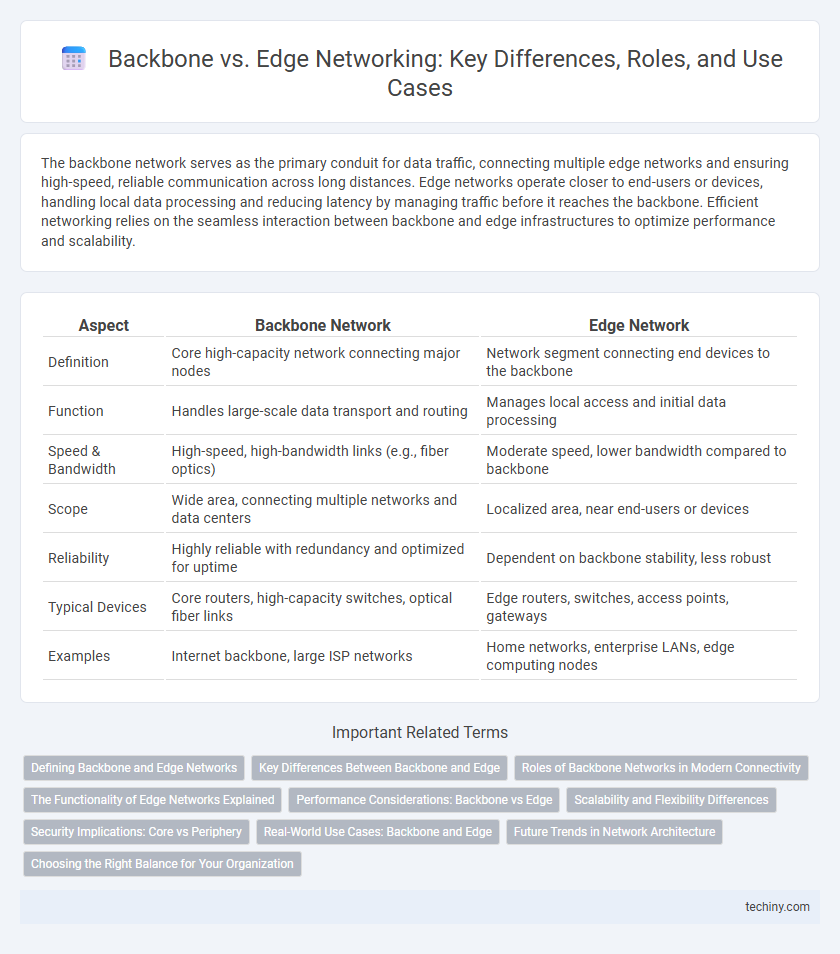The backbone network serves as the primary conduit for data traffic, connecting multiple edge networks and ensuring high-speed, reliable communication across long distances. Edge networks operate closer to end-users or devices, handling local data processing and reducing latency by managing traffic before it reaches the backbone. Efficient networking relies on the seamless interaction between backbone and edge infrastructures to optimize performance and scalability.
Table of Comparison
| Aspect | Backbone Network | Edge Network |
|---|---|---|
| Definition | Core high-capacity network connecting major nodes | Network segment connecting end devices to the backbone |
| Function | Handles large-scale data transport and routing | Manages local access and initial data processing |
| Speed & Bandwidth | High-speed, high-bandwidth links (e.g., fiber optics) | Moderate speed, lower bandwidth compared to backbone |
| Scope | Wide area, connecting multiple networks and data centers | Localized area, near end-users or devices |
| Reliability | Highly reliable with redundancy and optimized for uptime | Dependent on backbone stability, less robust |
| Typical Devices | Core routers, high-capacity switches, optical fiber links | Edge routers, switches, access points, gateways |
| Examples | Internet backbone, large ISP networks | Home networks, enterprise LANs, edge computing nodes |
Defining Backbone and Edge Networks
Backbone networks are high-capacity communication pathways that connect various subnetworks, enabling large-scale data transmission across core infrastructure with minimal latency. Edge networks serve as the access layer, linking end-user devices and local nodes to the backbone, optimizing data processing closer to the source. Defining backbone and edge networks highlights the distinction between centralized, high-throughput core networks and distributed, low-latency access networks essential for scalable and efficient network architecture.
Key Differences Between Backbone and Edge
The backbone network serves as the primary data route that interconnects different segments and carries large volumes of traffic across long distances, while edge networks operate closer to end users, managing local data processing and access. Backbone networks typically feature high-capacity, high-speed links such as fiber optics with advanced routing equipment, whereas edge networks prioritize lower latency and localized control through switches and access points. Key differences include scale, capacity, and role in network architecture, with backbone focusing on central aggregation and edge emphasizing user connectivity and real-time data handling.
Roles of Backbone Networks in Modern Connectivity
Backbone networks serve as the primary high-capacity routes that interconnect different edge networks, ensuring efficient data transmission across vast distances and diverse geographic locations. They manage core routing, facilitate high-speed data transfer, and provide redundancy to maintain network reliability and minimize latency. By aggregating traffic from multiple edge networks, backbone networks enable scalable and robust modern connectivity essential for cloud services, data centers, and global communications.
The Functionality of Edge Networks Explained
Edge networks function as the decentralized nodes that bring data processing and connectivity closer to end-users, reducing latency and improving real-time responsiveness. They manage local traffic, provide security filtering, and support services like IoT device integration and content delivery at the network periphery. This localized processing contrasts with backbone networks that primarily handle high-capacity data transit across long distances and core infrastructure.
Performance Considerations: Backbone vs Edge
Performance considerations in networking highlight that backbone networks require high throughput and low latency to handle aggregated traffic from multiple edge segments efficiently. Edge networks prioritize flexibility and scalability, managing varied device connections and localized data processing with lower bandwidth compared to the backbone. Optimizing backbone capacity with technologies like high-speed fiber optics and edge computing enhances overall network performance and reduces bottlenecks.
Scalability and Flexibility Differences
Backbone networks prioritize scalability by supporting high-capacity data transmission across extensive geographic regions with robust infrastructure and high-speed links, enabling seamless integration of multiple edge networks. Edge networks focus on flexibility by adapting to localized user demands, offering customizable configurations and lower latency for diverse applications and dynamic workloads at the network periphery. Scalability in backbone networks achieves wide-area connectivity and traffic aggregation, while edge networks enhance responsiveness and user experience through localized processing and adaptability.
Security Implications: Core vs Periphery
Backbone networks centralize critical data flow, making them prime targets for high-impact cyberattacks and requiring robust, multilayered security protocols such as advanced firewalls and intrusion detection systems. Edge networks expose endpoints to greater risk from external threats, necessitating localized security measures like endpoint protection, network segmentation, and real-time monitoring to mitigate vulnerabilities. Securing the core backbone ensures overall network integrity, while fortifying the edge protects against perimeter breaches and lateral movement of attackers.
Real-World Use Cases: Backbone and Edge
Backbone networks provide high-capacity, long-distance data transport essential for connecting large geographic regions and supporting data centers, telecommunications providers, and internet service providers. Edge networks focus on localized data processing, reducing latency and bandwidth usage by handling data near the source, crucial for IoT devices, content delivery networks (CDNs), and real-time applications like autonomous vehicles or smart cities. Real-world implementations demonstrate backbone networks as the core internet infrastructure, while edge networks enable faster, efficient user experiences and support emerging technologies requiring immediate data access.
Future Trends in Network Architecture
Future network architectures emphasize the integration of backbone and edge components to optimize data flow and reduce latency. Advances in edge computing and 5G technology drive distributed networks where backbone infrastructures support high-capacity core traffic while edge nodes handle localized processing and real-time analytics. Emerging trends include AI-powered traffic management and enhanced security protocols that dynamically adapt across backbone and edge layers to meet evolving demands.
Choosing the Right Balance for Your Organization
Selecting the ideal balance between backbone and edge networking depends on an organization's size, data flow, and security requirements. Backbone networks provide high-speed, reliable connections supporting core infrastructure, while edge networks enhance local processing and reduce latency by handling data closer to end-users. Efficient integration of both enables scalable performance and optimized resource allocation tailored to specific operational demands.
Backbone vs Edge Infographic

 techiny.com
techiny.com